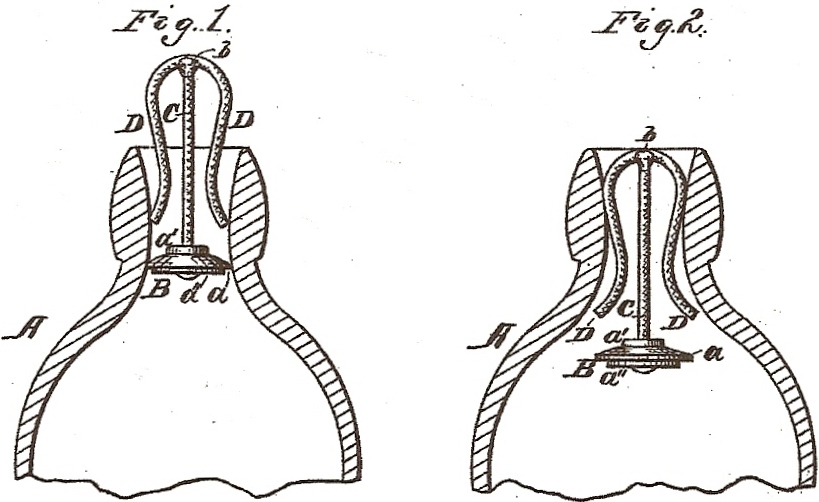Charles G. Hutchinson Bottle Stopper

UNITED STATES PATENT OFFICE
CHARLES G.
HUTCHINSON, OF
IMPROVEMENT IN BOTTLE-STOPPERS.
Specification forming part of Letters
Patent No. 285,488,
dated September 25, 1883, application
filed March 8, 1881.
To all whom it may concern:
Be it known that I, CHARLES G. HUTCHINSON, of
In the drawings, Figure 1 is a vertical central
section of the upper part of a bottle containing a stopper embodying my
invention, showing the stopper in position for closing the neck; and
Fig. 2 is a like representation, showing the bottle opened.
Like letters of reference indicate like parts.
A represents the
bottle.
B is the valve or stopper
proper. The valve in the
example shown consists of a rubber disk,
a, arranged between two
metallic disks, a’ and
a’’, the latter or lower one
of which is larger than the disk
a’, but not so large as the disk
a.
The diameter of the disk a’’ should be such as to permit the stopper to be pushed down
through the neck, and such as to cause the edge of the disk a to be
pinched by the neck sufficiently to prevent the valve from being drawn
out by raising the stopper, it being understood that the diameter of the
disk a is great enough for that purpose.
The disk a’, by having
a diameter much less than that of the disk a, permits the edge of the
latter to be raised so that the valve may be thrust below its seat.
I am aware that the bottle and valve herein shown and
described have heretofore been combined so as to operate together in the
manner now set forth; but the essential features of my present invention
are those which relate to the means employed for controlling the
position of the valve, and which I now proceed to describe.
C is a stem
projecting vertically from the valve
B, and D D are
laterally-yielding arms applied to the said stem.
It will be perceived by referring to the drawings that in
structure and arrangement the arms
D D are such as to hold the valve up against its seat, or in its
closed position; that they will suspend it in its open position, or
prevent it from falling to the bottom of the bottle, and also that they
will prevent the valve from being carried to its seat by the outpouring
of the contents. It is also
obvious that the stopper may be drawn to its closed position with
facility by means of a small hook, and that it may be easily opened by
pushing it downward sufficiently for that purpose.
The disk a
may be applied by being punched out at its center for being passed down
upon the stem C, and, after
being pushed down to the disk a’,
the disk a may be stretched over the upper metallic disk, it being
understood that the arms D D
are to be applied afterward.
Having thus described my invention, what I claim as
new, and desire to secure by Letters Patent, is –
An internal bottle-stopper in which the valve is
provided with a central vertical stem extending above it and made in two
parts, one consisting of the central wire or stem,
C, and the other of a
bow-shaped wire attached at the concavity of its bow-shaped part to the
upper end of the part C, and
forming laterally-yielding depending arms
D D, having free or loose
lower ends, substantially as shown and described, and for the purposes
set forth.
CHARLES G. HUTCHINSON.
Witnesses: F. F. Warner,
George F. Borman.
Comments:
Charles G. Hutchinson’s five bottle-stopper patents
are included in their entirety to serve as reference sources for
tracking their design evolution.
Also see:
U.S. Patent Number: 219,729 Patented: September 16, 1879
U.S. Patent Number: 225,476 Patented: March 16, 1880
 HutchBook.com
HutchBook.com